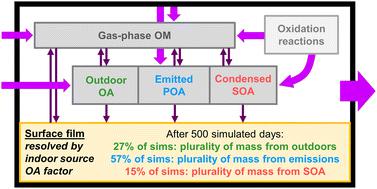当前位置:
X-MOL 学术
›
Environ. Sci.: Processes Impacts
›
论文详情
Our official English website, www.x-mol.net, welcomes your feedback! (Note: you will need to create a separate account there.)
Composition of indoor organic surface films in residences: simulating the influence of sources, partitioning, particle deposition, and air exchange
Environmental Science: Processes & Impacts ( IF 5.5 ) Pub Date : 2023-12-18 , DOI: 10.1039/d3em00399j Bryan E. Cummings 1 , Pascale S. J. Lakey 2 , Glenn C. Morrison 3 , Manabu Shiraiwa 2 , Michael S. Waring 1
Environmental Science: Processes & Impacts ( IF 5.5 ) Pub Date : 2023-12-18 , DOI: 10.1039/d3em00399j Bryan E. Cummings 1 , Pascale S. J. Lakey 2 , Glenn C. Morrison 3 , Manabu Shiraiwa 2 , Michael S. Waring 1
Affiliation

|
Indoor surfaces are coated with organic films that modulate thermodynamic interactions between the surfaces and room air. Recently published models can simulate film formation and growth via gas-surface partitioning, but none have statistically investigated film composition. The Indoor Model of Aerosols, Gases, Emissions, and Surfaces (IMAGES) was used here to simulate ten years of nonreactive film growth upon impervious indoor surfaces within a Monte Carlo procedure representing a sub-set of North American residential buildings. Film composition was resolved into categories reflecting indoor aerosol (gas + particle phases) factors from three sources: outdoor-originating, indoor-emitted, and indoor-generated secondary organic material. In addition to gas-to-film partitioning, particle deposition was modeled as a vector for organics to enter films, and it was responsible for a majority of the film mass after ∼1000 days of growth for the median simulation and is likely the main source of LVOCs within films. Therefore, the organic aerosol factor possessing the most SVOCs contributes most strongly to the composition of early films, but as the film ages, films become more dominated by the factor with the highest particle concentration. Indoor-emitted organics (e.g. from cooking) often constituted at least a plurality of the simulated mass in developed films, but indoor environments are diverse enough that any major organic material source could be the majority contributor to film mass, depending on building characteristics and indoor activities. A sensitivity analysis suggests that rapid film growth is most likely in both newer, more air-tight homes and older homes near primary pollution sources.
中文翻译:

住宅室内有机表面膜的组成:模拟源、分区、颗粒沉积和空气交换的影响
室内表面涂有有机薄膜,可调节表面与室内空气之间的热力学相互作用。最近发表的模型可以通过气体表面分配来模拟薄膜形成和生长,但没有一个模型对薄膜成分进行统计研究。这里使用气溶胶、气体、排放物和表面的室内模型 (IMAGES) 来模拟代表北美住宅建筑子集的蒙特卡罗程序中不透水的室内表面上十年的非反应性薄膜生长。薄膜成分被分解为反映来自三个来源的室内气溶胶(气体+颗粒相)因素的类别:室外产生的、室内排放的和室内产生的二次有机材料。除了气体与薄膜的分配之外,颗粒沉积还被建模为有机物进入薄膜的载体,在中值模拟中,它在约 1000 天的生长后形成了大部分薄膜质量,并且可能是主要来源薄膜中 LVOC 的含量。因此,拥有最多 SVOC 的有机气溶胶因子对早期薄膜的组成贡献最大,但随着薄膜的老化,薄膜变得更受颗粒浓度最高的因子的支配。室内排放的有机物(例如来自烹饪)通常至少构成冲洗胶片中的多个模拟质量,但室内环境足够多样化,任何主要根据建筑特征和室内活动,有机材料来源可能是薄膜质量的主要贡献者。敏感性分析表明,在主要污染源附近的较新、气密性较高的房屋和较旧的房屋中,薄膜最有可能快速生长。
更新日期:2023-12-18
中文翻译:

住宅室内有机表面膜的组成:模拟源、分区、颗粒沉积和空气交换的影响
室内表面涂有有机薄膜,可调节表面与室内空气之间的热力学相互作用。最近发表的模型可以通过气体表面分配来模拟薄膜形成和生长,但没有一个模型对薄膜成分进行统计研究。这里使用气溶胶、气体、排放物和表面的室内模型 (IMAGES) 来模拟代表北美住宅建筑子集的蒙特卡罗程序中不透水的室内表面上十年的非反应性薄膜生长。薄膜成分被分解为反映来自三个来源的室内气溶胶(气体+颗粒相)因素的类别:室外产生的、室内排放的和室内产生的二次有机材料。除了气体与薄膜的分配之外,颗粒沉积还被建模为有机物进入薄膜的载体,在中值模拟中,它在约 1000 天的生长后形成了大部分薄膜质量,并且可能是主要来源薄膜中 LVOC 的含量。因此,拥有最多 SVOC 的有机气溶胶因子对早期薄膜的组成贡献最大,但随着薄膜的老化,薄膜变得更受颗粒浓度最高的因子的支配。室内排放的有机物(例如来自烹饪)通常至少构成冲洗胶片中的多个模拟质量,但室内环境足够多样化,任何主要根据建筑特征和室内活动,有机材料来源可能是薄膜质量的主要贡献者。敏感性分析表明,在主要污染源附近的较新、气密性较高的房屋和较旧的房屋中,薄膜最有可能快速生长。



























 京公网安备 11010802027423号
京公网安备 11010802027423号